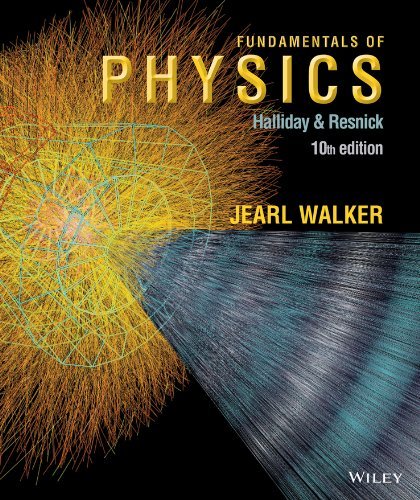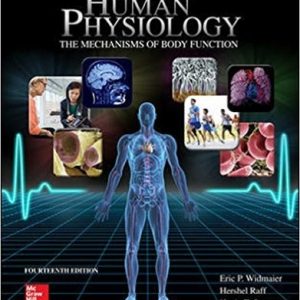Instant download Fundamentals of Physics Halliday 10th Edition Test Bank pdf docx epub after payment.

Product details:
- ISBN-10 : 1118230728
- ISBN-13 : 978-1118230725
- Author: Robert Resnick; David Halliday
The 10th edition of Halliday’s Fundamentals of Physics, Extended building upon previous issues by offering several new features and additions. The new edition offers most accurate, extensive and varied set of assessment questions of any course management program in addition to all questions including some form of question assistance including answer specific feedback to facilitate success. The text also offers multimedia presentations (videos and animations) of much of the material that provide an alternative pathway through the material for those who struggle with reading scientific exposition. Furthermore, the book includes math review content in both a self-study module for more in-depth review and also in just-in-time math videos for a quick refresher on a specific topic. The Halliday content is widely accepted as clear, correct, and complete. The end-of-chapters problems are without peer. The new design, which was introduced in 9e continues with 10e, making this new edition of Halliday the most accessible and reader-friendly book on the market.
Table of contents:
- Chapter 1: Measurement
- 1.1: Measuring Things, Including Lengths (9)
- 1.2: Time (8)
- 1.3: Mass (10)
- 1: Additional Problems (25)
- 1: Extra Problems (8)
- 1: Simulation Problems
- 1: Symbolic Questions
- 1: Test Bank Questions (37)
- Chapter 2: Motion Along a Straight Line
- 2: Concept Questions (4)
- 2.1: Position, Displacement, and Average Velocity (11)
- 2.2: Instantaneous Velocity and Speed (4)
- 2.3: Acceleration (5)
- 2.4: Constant Acceleration (19)
- 2.5: Free-Fall Acceleration (18)
- 2.6: Graphical Integration in Motion Analysis (2)
- 2: Additional Problems (32)
- 2: Extra Problems (15)
- 2: Simulation Problems (8)
- 2: Symbolic Questions (3)
- 2: Test Bank Questions (90)
- Chapter 3: Vectors
- 3: Concept Questions (8)
- 3.1: Vectors and Their Components (7)
- 3.2: Unit Vectors, Adding Vectors by Components (23)
- 3.3: Multiplying Vectors (12)
- 3: Additional Problems (27)
- 3: Extra Problems (9)
- 3: Simulation Problems (2)
- 3: Symbolic Questions
- 3: Test Bank Questions (43)
- Chapter 4: Motion in Two and Three Dimensions
- 4: Concept Questions (4)
- 4.1: Position and Displacement (4)
- 4.2: Average Velocity and Instantaneous Velocity (6)
- 4.3: Average Acceleration and Instantaneous Acceleration (10)
- 4.4: Projectile Motion (25)
- 4.5: Uniform Circular Motion (10)
- 4.6: Relative Motion in One Dimension (3)
- 4.7: Relative Motion in Two Dimensions (8)
- 4: Additional Problems (33)
- 4: Extra Problems (13)
- 4: Simulation Problems (4)
- 4: Symbolic Questions (5)
- 4: Test Bank Questions (56)
- Chapter 5: Force and Motion–I
- 5: Concept Questions (6)
- 5.1: Newton’s First and Second Laws (11)
- 5.2: Some Particular Forces (3)
- 5.3: Applying Newton’s Laws (43)
- 5: Additional Problems (23)
- 5: Extra Problems (10)
- 5: Simulation Problems (5)
- 5: Symbolic Questions (4)
- 5: Test Bank Questions (74)
- Chapter 6: Force and Motion–II
- 6: Concept Questions (7)
- 6.1: Friction (33)
- 6.2: The Drag Force and Terminal Speed (3)
- 6.3: Uniform Circular Motion (17)
- 6: Additional Problems (39)
- 6: Extra Problems (11)
- 6: Simulation Problems (10)
- 6: Symbolic Questions (4)
- 6: Test Bank Questions (74)
- Chapter 7: Kinetic Energy and Work
- 7: Concept Questions (7)
- 7.1: Kinetic Energy (4)
- 7.2: Work and Kinetic Energy (9)
- 7.3: Work Done by the Gravitational Force (9)
- 7.4: Work Done by a Spring Force (6)
- 7.5: Work Done by a General Variable Force (7)
- 7.6: Power (10)
- 7: Additional Problems (24)
- 7: Extra Problems (3)
- 7: Simulation Problems (2)
- 7: Symbolic Questions (4)
- 7: Test Bank Questions (73)
- Chapter 8: Potential Energy and Conservation of Energy
- 8: Concept Questions (6)
- 8.1: Potential Energy (7)
- 8.2: Conservation of Mechanical Energy (25)
- 8.3: Reading a Potential Energy Curve (2)
- 8.4: Work Done on a System by an External Force (4)
- 8.5: Conservation of Energy (18)
- 8: Additional Problems (51)
- 8: Extra Problems (12)
- 8: Simulation Problems
- 8: Symbolic Questions (6)
- 8: Test Bank Questions (65)
- Chapter 9: Center of Mass and Linear Momentum
- 9: Concept Questions (9)
- 9.1: Center of Mass (8)
- 9.2: Newton’s Second Law for a System of Particles (9)
- 9.3: Linear Momentum (4)
- 9.4: Collision and Impulse (16)
- 9.5: Conservation of Linear Momentum (7)
- 9.6: Momentum and Kinetic Energy in Collisions (11)
- 9.7: Elastic Collisions in One Dimension (11)
- 9.8: Collisions in Two Dimensions (5)
- 9.9: Systems with Varying Mass: A Rocket (4)
- 9: Additional Problems (44)
- 9: Extra Problems (21)
- 9: Simulation Problems (6)
- 9: Symbolic Questions (5)
- 9: Test Bank Questions (100)
- Chapter 10: Rotation
- 10: Concept Questions (7)
- 10.1: Rotational Variables (7)
- 10.2: Rotation with Constant Angular Acceleration (11)
- 10.3: Relating the Linear and Angular Variables (12)
- 10.4: Kinetic Energy of Rotation (2)
- 10.5: Calculating the Rotational Inertia (10)
- 10.6: Torque (4)
- 10.7: Newton’s Second Law for Rotation (9)
- 10.8: Work and Rotational Kinetic Energy (10)
- 10: Additional Problems (31)
- 10: Extra Problems (16)
- 10: Simulation Problems (6)
- 10: Symbolic Questions (5)
- 10: Test Bank Questions (101)
- Chapter 11: Rolling, Torque, and Angular Momentum
- 11: Concept Questions (7)
- 11.1: Rolling as Translation and Rotation Combined (2)
- 11.2: Forces and Kinetic Energy of Rolling (13)
- 11.3: The Yo-Yo (3)
- 11.4: Torque Revisited (6)
- 11.5: Angular Momentum (6)
- 11.6: Newton’s Second Law in Angular Form (3)
- 11.7: Angular Momentum of a Rigid Body (5)
- 11.8: Conservation of Angular Momentum (23)
- 11.9: Precession of a Gyroscope (1)
- 11: Additional Problems (17)
- 11: Extra Problems (14)
- 11: Simulation Problems
- 11: Symbolic Questions (7)
- 11: Test Bank Questions (67)
- Chapter 12: Equilibrium and Elasticity
- 12: Concept Questions (3)
- 12.1: Equilibrium (1)
- 12.2: Some Examples of Static Equilibrium (32)
- 12.3: Elasticity (6)
- 12: Additional Problems (20)
- 12: Extra Problems (4)
- 12: Simulation Problems (2)
- 12: Symbolic Questions (6)
- 12: Test Bank Questions (57)
- Chapter 13: Gravitation
- 13: Concept Questions (3)
- 13.1: Newton’s Law of Gravitation (5)
- 13.2: Gravitation and the Principle of Superposition (8)
- 13.3: Gravitation Near Earth’s Surface (5)
- 13.4: Gravitation Inside Earth (5)
- 13.5: Gravitational Potential Energy (12)
- 13.6: Planets and Satellites: Kepler’s Laws (12)
- 13.7: Satellites: Orbits and Energy (5)
- 13.8: Einstein and Gravitation (1)
- 13: Additional Problems (16)
- 13: Extra Problems (5)
- 13: Simulation Problems (1)
- 13: Symbolic Questions (5)
- 13: Test Bank Questions (61)
- Chapter 14: Fluids
- 14: Concept Questions (2)
- 14.1: Fluids, Density, and Pressure (6)
- 14.2: Fluids at Rest (11)
- 14.3: Measuring Pressure (2)
- 14.4: Pascal’s Principle (1)
- 14.5: Archimedes’ Principle (13)
- 14.6: The Equation of Continuity (4)
- 14.7: Bernoulli’s Equation (9)
- 14: Additional Problems (7)
- 14: Extra Problems
- 14: Simulation Problems
- 14: Symbolic Questions (5)
- 14: Test Bank Questions (90)
- Chapter 15: Oscillations
- 15: Concept Questions (4)
- 15.1: Simple Harmonic Motion (22)
- 15.2: Energy in Simple Harmonic Motion (9)
- 15.3: An Angular Simple Harmonic Oscillator (2)
- 15.4: Pendulums, Circular Motion (11)
- 15.5: Damped Simple Harmonic Motion (3)
- 15.6: Forced Oscillations and Resonance (2)
- 15: Additional Problems (26)
- 15: Extra Problems (4)
- 15: Simulation Problems (1)
- 15: Symbolic Questions (5)
- 15: Test Bank Questions (80)
- Chapter 16: Waves–I
- 16: Concept Questions (1)
- 16.1: Transverse Waves (9)
- 16.2: Wave Speed on a Stretched String (9)
- 16.3: Energy and Power of a Wave Traveling Along a String (2)
- 16.4: The Wave Equation (2)
- 16.5: Interference of Waves (2)
- 16.6: Phasors (2)
- 16.7: Standing Waves and Resonance (17)
- 16: Additional Problems (20)
- 16: Extra Problems
- 16: Simulation Problems (6)
- 16: Symbolic Questions (5)
- 16: Test Bank Questions (83)
- Chapter 17: Waves–II
- 17: Concept Questions (1)
- 17.1: Speed of Sound (5)
- 17.2: Traveling Sound Waves (4)
- 17.3: Interference (6)
- 17.4: Intensity and Sound Level (10)
- 17.5: Sources of Musical Sound (8)
- 17.6: Beats (4)
- 17.7: The Doppler Effect (9)
- 17.8: Supersonic Speeds, Shock Waves (1)
- 17: Additional Problems (17)
- 17: Extra Problems (3)
- 17: Simulation Problems (4)
- 17: Symbolic Questions (5)
- 17: Test Bank Questions (72)
- Chapter 18: Temperature, Heat, and the First Law of Thermodynamics
- 18: Concept Questions (1)
- 18.1: Temperature (1)
- 18.2: The Celsius and Fahrenheit Scales (3)
- 18.3: Thermal Expansion (9)
- 18.4: Absorption of Heat (16)
- 18.5: The First Law of Thermodynamics (5)
- 18.6: Heat Transfer Mechanisms (11)
- 18: Additional Problems (8)
- 18: Extra Problems (2)
- 18: Simulation Problems
- 18: Symbolic Questions (5)
- 18: Test Bank Questions (96)
- Chapter 19: The Kinetic Theory of Gases
- 19: Concept Questions (1)
- 19.1: Avogadro’s Number (2)
- 19.2: Ideal Gases (11)
- 19.3: Pressure, Temperature, and RMS Speed (7)
- 19.4: Translational Kinetic Energy (1)
- 19.5: Mean Free Path (3)
- 19.6: The Distribution of Molecular Speeds (4)
- 19.7: The Molar Specific Heats of an Ideal Gas (5)
- 19.8: Degrees of Freedom and Molar Specific Heats (2)
- 19.9: The Adiabatic Expansion of an Ideal Gas (6)
- 19: Additional Problems (7)
- 19: Extra Problems (6)
- 19: Simulation Problems
- 19: Symbolic Questions (5)
- 19: Test Bank Questions (114)
- Chapter 20: Entropy and the Second Law of Thermodynamics
- 20: Concept Questions (1)
- 20.1: Entropy (14)
- 20.2: Entropy in the Real World: Engines (8)
- 20.3: Refrigerators and Real Engines (8)
- 20.4: A Statistical View of Entropy (1)
- 20: Additional Problems (10)
- 20: Extra Problems (1)
- 20: Simulation Problems
- 20: Symbolic Questions (5)
- 20: Test Bank Questions (61)
- Chapter 21: Coulomb’s Law
- 21: Concept Questions (7)
- 21.1: Coulomb’s Law (21)
- 21.2: Charge Is Quantized (11)
- 21.3: Charge Is Conserved (1)
- 21: Additional Problems (24)
- 21: Extra Problems (2)
- 21: Simulation Problems
- 21: Symbolic Questions
- 21: Test Bank Questions (52)
- Chapter 22: Electric Fields
- 22: Concept Questions (6)
- 22.1: The Electric Field (1)
- 22.2: The Electric Field Due to a Charge Particle (15)
- 22.3: The Electric Field Due to a Dipole (1)
- 22.4: The Electric Field Due to a Line of Change (10)
- 22.5: The Electric Field Due to a Charged Disk (6)
- 22.6: A Point Charge in an Electric Field (16)
- 22.7: A Dipole in an Electric Field (5)
- 22: Additional Problems (22)
- 22: Extra Problems (2)
- 22: Simulation Problems (1)
- 22: Symbolic Questions (4)
- 22: Test Bank Questions (55)
People also search:
Fundamentals of Physics Halliday 10th Edition
Fundamentals of Physics Halliday 10th Edition pdf
Fundamentals of Physics Halliday
fundamentals of physics by halliday resnick and walker
which is better resnick halliday or university physics





